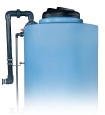In industry, a great deal of manufacturing is made from very few chemicals. Here are four of the most commonly produced and used chemicals. All of these chemicals are produced in excess of 100 million metric tons per year.
Topics:
Chemicals,
Chemical Storage
If your industrial company produces hazardous runoff from operating equipment, you need to treat the wastewater before dumping it into the sewer or wastewater stream. Depending on your industry, you may need to have a very detailed process that meets the highest standards. Each state and city might have their own standards and regulations you’ll need to meet, or you might be under federal regulations.
Topics:
Chemicals,
Tank Design and Materials,
Chemical Storage
Your double walled tank could be violating the Code of Federal Regulations (CFR) without your knowledge — even if there’s nothing wrong with the tank itself. The CFR contains requirements designed to protect the environment from exposure to hazardous chemicals.
Topics:
Fittings and Accessories,
Tank Design and Materials,
Chemical Storage
Paper mills use harsh chemicals on a daily basis in the production of pulp and paper. These chemicals can be hazardous to the environment and to workers’ health, so it’s critical to install a chemical storage system you can rely on.
Topics:
Chemicals,
Chemical Storage
Poly Processing tanks are used worldwide for water and wastewater treatment applications, but our tanks are also found in dozens of industries as well. We’re able to work with and provide solutions to a wide variety of businesses and organizations that use tanks to store chemicals and other materials.
Topics:
Fittings and Accessories,
Chemical Storage
Whether you’re an engineer writing a spec for a chemical storage system, or an end-user who is looking for the best way to store corrosive chemicals, there are multiple factors that go into creating a safe storage system. Cost might be your first consideration, but there is more to consider than the initial price of the tank, its fittings and accessories, delivery, installation, and tank longevity.
Topics:
Chemicals,
Tank Design and Materials
Polymers are important chemicals used in the headworks of wastewater treatment plants. They facilitate the flocculation or coagulation of solids in the wastewater to produce large curds of solid materials. They also aid in dewatering of digester cake — reducing the water content to make it easier and less expensive to transport waste materials to the landfill. Polymers are highly viscous environmental stress cracking agents, which means they present unique storage challenges that require the right storage solution for adequate safety and cost effectiveness. Let’s explore these challenges and solutions.
Topics:
Chemicals
Sodium hypochlorite is a chemical used in thousands of applications. As an aggressive oxidizer, it’s critical to limit the opportunity for the chemical to escape the storage tank. If you’re using a polyethylene tank to store oxidizing chemicals, you can multiply the useful life of your chemical storage tank by using an engineered polyethylene antioxidant tank system.
Topics:
Tank Design and Materials
When you design a chemical storage tank system, you have to consider the factors that impact the tank’s service life. Not only do you have to make sure that the tank material and fitting materials are compatible with the chemical you’re storing, it’s also important to consider the functionality of the tank — for example, how it responds to pressure. You need to know exactly how much pressure your chemical storage tank can safely handle. This is an issue for every chemical tank, no matter what material it’s made of. Fortunately, cross-linked polyethylene storage tanks have remarkable durability compared to many other materials. That said, you need to know your tank’s pressure limits.
Topics:
Fittings and Accessories
Once your food production facility outgrows your 300-gallon totes, it’s time to look into larger storage tanks for food storage and clean-in-place chemicals. There are several options on the market to choose from, but you’ll need to consider which storage tank can meet your greatest challenges: FDA requirements, full-drain capabilities, and cost-effectiveness.
Topics:
Chemicals



